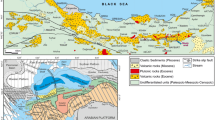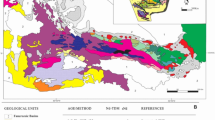Abstract
Sr- and Pb-isotope data from the Calabozos center (87Sr/86Sr=∼ 0.7043, 206Pb/204Pb=18.64–18.66, 207Pb/204Pb=15.59–15.60, 208Pb/204Pb=38.52–38.55) fall within the range of values reported for the southern volcanic zone (33–42° S) of the Andean arc. The range of δ 18O (5.0–6.3), however, includes unusually low values compared to volcanic rocks of similar bulk composition in the region. The Calabozos caldera complex lies at 35 °30′ S, where the continental crust under the Andes thins southward from >45 to ∼ 30 km. Three voluminous late Pleistocene ashflow tuffs, collectively called the Loma Seca Tuff, constitute the bulk of >1,000 km3 of eruptive products at the Calabozos caldera complex and are evidence for a major, longlived andesitic-to-rhyodacitic magma reservoir at shallow crustal levels. The δ 18O values of the most evolved volcanic rocks from the Calabozos center are lower than predicted for rhyodacite produced by crystal fractionation from basalt typical of the region. Variation of δ 18O independent of bulk composition and inferred magmatic water contents indicates that the 18O depletion is a late-stage, upper-crustal phenomenon that cannot simply be attributed to magmatic interaction with meteoric water. The data are interpreted to be the result of assimilation of 5–30% of roof and wall rocks previously depleted in 18O by isotopic exchange in a meteoric hydrothermal system overlying the magma reservoir. Combined assimilation and fractional crystallization calculations applied to Sr isotope data show that the isotopic contrast between the Calabozos magmas and the assimilated rocks is very small. Hydrothermally-altered volcanic and plutonic rocks from the Tertiary Andean arc complex and Mesozoic-to-Cenozoic volcaniclastic sediments typical of the local basement provide a geologically reasonable contaminant compatible with the Sr- and O-isotope data. Pb-isotope data from the Calabozos system lend no significant insight into upper crustal contamination.
Similar content being viewed by others
References
Anderson AT, Clayton RN, Mayeda TK (1971) Oxygen isotope thermometry of mafic igneous rocks. J Geol 6:715–729
Baker MCW, Francis PW (1978) Upper Cenozoic volcanism in the central Andes-Ages and volumes. Earth Planet Sci Lett 41:175–187
Barreiro BA (1984) Lead isotopes and Andean magmagenesis. In: Andean magmatism-chemical and isotopic constraints. RS Harmon, BA Barreiro (eds) Nantwich, Cheshire, UK, Shiva, pp 21–30
Barreiro BA, Cameron M, Cameron K, Grunder AL (1982) A lead isotope study of silicic and intermediate volcanic rocks from south-central Chile and the Sierra Madre Occidental, Maxico. Carnegie Inst Wash Yearb, DTM, Annual Report 1981–1982:494–498
Borthwick J, Harmon RS (1982) A note regarding CIF3 as an alternative to BrF5 for oxygen isotope analysis. Geochim Cosmochim Acta 46:1665–1668
Caminos R, Cingolani CA, Hervé F, Linares E (1982) Geochronology of the pre-Andean metamorphism and magmatism in the Andean Cordillera between latitudes 30° and 36° S. Earth Sci Rev 18:333–352
Chow TJ, Patterson CC (1962) The occurrence and significance of lead isotopes in pelagic sediments. Geochim Cosmochim Acta 26:263–308
Déruelle B (1982) Petrology of the Plio-Quaternary volcanism of the south-central and meridional Andes. J Volcanol Geotherm Res 14:77–124
Déruelle B, Harmon RS, Moorbath S (1983) Combined Sr-O isotope relationships and petrogenesis of Andean volcanics of South America. Nature 302:814–816
DePaolo DJ (1981a) A Neodymium and Strontium isotopic study of the Mesozoic calc-alkaline granitic batholiths of the Sierra Nevada and Peninsular Ranges, California. J Geophys Res B11:10470–10488
DePaolo DJ (1981b) Trace element and isotopic effects of combined wallrock assimilation and fractional crystallization. Earth Planet Sci Lett 53:189–202
Drake RE (1976) Chronology of Cenozoic igneous and tectonic events in the central Chilean Andes-Latitudes 35°30′ to 36°S. J Volcanol Geotherm Res 1:265–284
Drake RE, Vergara M, Munizaga F, Vicente JC (1982) Geochronology of Mesozoic-Cenozoic magmatism in central Chile, Lat. 31°–36°S. Earth Sci Rev 18:353–363
Ferriz H, Mahood GA (1984) Eruption rates and compositional trends at Los Humeros volcanic center, Puebla, Maxico. J Geophys Res 89:8511–8524
Frey FA, Gerlach DC, Hickey RL, López L (1984) Petrogenesis of the Laguna del Maule volcanic complex (36° S). Contrib Mineral Petrol 88:133–149
Garlick GD (1966) Oxygen isotope fractionation in igneous rocks. Earth Planet Sci Lett 1:361–368
Gerlach DC (1984) Magma mixing and geochemically heterogeneous basalts, Puyehue Volcano, Chile (40.5°S). In: Proc Conf on Open Magmatic Systems, MA Dungan, TL Grove, W Hildreth (eds) Southern Methodist University, Dallas, Texas, pp 53–55
Gerlach DC, Frey FA (1984) Magma mixing and geochemically heterogeneous basalts, Puyehue Volcano, Chile (40.5°S). Geol Soc Am Abstr Prog 6:517
Gerlach DC, Frey FA, Hickey R, Moreno-Roa H, Hildreth W (1983) Geochemistry of Puyehue volcano and Cordon Caulle, South Andes (45.5°S). Trans Am Geophys Union 64:326
González-Ferrán O, Vergara M (1962) Reconocimiento geologico de la Cordillera de los Andes entre los paralelos 35° y 38° latitud sur. Univ Chile, Instituto de Geologiá Publicacion 24:121
Grunder AL (1986) The Calabozos caldera complex: Geology, petrology, and geochemistry of a major silicic volcanic center and hydrothermal system in the southern Andes. Ph. D Thesis, Stanford University, Stanford, CA
Grunder AL, Mahood GA (in preparation) Petrologic evolution of a major, late Pleistocene, compositionally zoned, silicic magma system in the southern Andes: the Calabozos caldera complex
Halliday AN, Fallick AE, Dickin AP, Mackenzie AB, Stephens WE, Hildreth W (1982) The isotopic evolution of Mount St. Helens. Earth Planet Sci Lett 63:241–256
Harmon RS, Barreiro BA, Moorbath S, Hoefs J, Francis PW, Thorpe RS, Déruelle B, McHugh J, Viglino JA (1984) Regional O-, Sr-, and Pb-isotopic relationships in late-Cenozoic calcalkaline lavas of the Andean Cordillera. J Geol Soc London 141:802–803
Harmon RS, Thorpe RS, Francis PW (1981) Petrogenesis of Andean andesites from combined O-Sr isotope relationships. Nature 290:396–399
Hawkesworth CJ, Norry MJ, Roddick JC, Baker PE, Francis PW, Thorpe RS (1979) 143Nd/144Nd, 87Sr/86Sr, and incompatible element variations in calc-alkaline andesites and plateau lavas from South America. Earth Planet Sci Lett 42:45–57
Hawkesworth CJ, Hammill M, Gledhill AR, van Calsteren P, Rogers G (1982) Isotope and trace element evidence for late-stage intracrustal melting in the high Andes. Earth Planet Sci Lett 58:240–254
Hayes DE (1966) A geophysical investigation of the Peru-Chile trench. Mar Geol 4:309–351
Hickey RL, Frey FA, Gerlach DC, López-Escobar L (1983) Isotopic and trace element data bearing on the origin of volcanic rocks from central south Chile. Trans Am Geophys Union 64:326
Hickey RL, Frey FA, Gerlach DC, Lopez-Escobar L (1986) Multiple sources for basaltic arc rocks from the southern volcanic zone of the Andes (34–41 °S): Trace element and isotopic evidence for contributions from subducted oceanic crust, mantle, and continental crust. J Geophys Res 91:5963–5984
Hickey RL, Gerlach DC, Frey FA (1984) Geochemical variations in volcanic rocks from central-south Chile. RS Harmon, BA Barreiro (eds) Nantwich, Cheshire, UK, Shiva, pp 73–95
Hildreth W (1981) Gradients in silicic magma chambers: Implications for lithospheric magmatism. J Geophys Res 86: 10153–10192
Hildreth W, Drake RE (1983) 1932 eruption of Quizapú, central Chilean Andes. Geol Soc Am Abst Prog 15:390
Hildreth W, Drake RE, Sharp WD (1981) Voluminous late Pleistocene ash-flow and caldera complex in the Andes of central Chile. Geol Soc Am Abst Prog 2:61
Hildreth W, Grunder AL, Drake RE (1984a) The Loma Seca Tuff and the Calabozos caldera: A major ash-flow and caldera complex in the southern Andes of central Chile. Geol Soc Am Bull 95:45–54
Hildreth W, Christiansen RL, O'Neil JR (1984b) Catastrophic isotopic modification of rhyolitic magma at times of caldera subsidence, Yellowstone plateau volcanic field. J Geophys Res 89:8339–8369
Isshiki N (1963) Petrology of the Hachijo-jima volcano group, Seven Izu Islands, Japan. J Faculty Science, Tokyo Univ 15:91–134
James DE (1971) Andean crustal and upper mantle structure. J Geophys Res 76:3246–3271
James DE (1981) Role of subducted continental material in the genesis of calc-alkaline volcanics of the central Andes. Geol Soc Am Mem 154:769–779
Klerkx J, Deutsch S, Pichler H, Zeil W (1977) Strontium isotopic composition and trace element data bearing on the origin of Cenozoic volcanic rocks of the central and southern Andes. J Volcanol Geotherm Res 2:49–71
Kyser TK, O'Neil JR, Carmichael ISE (1981) Oxygen isotope thermometry of basic lavas and mantle nodules. Contrib Mineral Petrol 77:11–23
Larson PB, Taylor HP Jr (1986) 18O/16O ratios in ash-flow tuffs and lavas erupted from the central Nevada caldera complex and the central San Juan caldera complex, Colorado. Contrib Mineral Petrol 92:146–156
Lipman PW, Friedman I (1975) Interatcion of meteoric water with magma: An oxygen-isotope study of the ash-flow sheets from southern Nevada. Geol Soc Am Bull 86:695–702
Lomnitz C (1962) On Andean structure. J Geophys Res 67:351–363
Longstaffe FJ, Clark AH, McNutt RH, Zentilli M (1983) Oxygen isotopic compositions of central Andean plutonic and volcanic rocks, latitudes 26°–29° south. Earth Planet Sci Lett 64:9–18
Lopez L, Munizaga F (1984) Caracteristicas geoquimicas y petrogenesis del complejo volcanico Laguna del Maule, Andes del Sur, 36°S. Revista Geologica de Chile 19–20:3–24
Magaritz M, Whitford DJ, James DE (1978) Oxygen isotopes and the origin of high 87Sr/86Sr andesites. Earth Planet Sci Lett 40:220–230
Matsuhisa Y (1979) Oxygen isotopic compositions of volcanic rocks from the East Japan island arcs and their bearing on petrogenesis. J Volcanol Geotherm Res 5:271–296
McNutt RH, Clark AH, Zentilli M (1979) Lead isotopic compositions of Andean igneous rocks, latitudes 26° to 29° S: Petrologic and metallogenic implications. Econ Geol 74:827–837
Muehlenbachs K, Byerly G (1982) 18O-enrichment of silicic magmas caused by crystal fractionation at the Galapagos spreading center. Contrib Mineral Petrol 79:76–79
Naney MT (1983) Phase equilibria of rock-forming ferromagnesian silicates in granitic systems. Am J Sci 283:993–1033
Noble DC (1965) Gold Flat member of the Thirsty Canyon Tuff — a pantellerite ash-flow sheet in southern Nevada. US Geol Surv Prof Pap 525-B: 85–90
Noble DC, Hedge CE (1970) 87Sr/86Sr variations within individual ash-flow sheets. US Geol Surv Prof Pap 650-C: 133–139
Perfit MR, Lawrence JR (1979) Oxygen isotopic evidence for meteoric water interaction with the Captains Bay pluton, Aleutian Islands. Earth Planet Sci Lett 45:16–22
Pichler H, Zeil W (1972) The Cenozoic rhyolite-andesite associations of the Chilean Andes. Bull Volcanol 35:424–452
Rye RO, Luhr JF, Wasserman MD (1984) Sulfur and Oxygen isotopic systematics of the 1982 eruptions of El Chichon volcano, Chiapas Maxico. J Volcanol Geotherm Res 23:109–123
Sheppard SMF, Harris C (1985) Hydrogen and oxygen isotope geochemistry of Ascension Island lavas and granites: variation with crystal fractionation. Contrib Mineral Petrol 91:74–81
Stern CR, Assad H, Charrier R, Godoy E, Hervé F, Varela J (1984a) Petrochemistry and age of rhyolitic pyroclastic flows which occur along the drainage valleys of the Rio Maipo and Rio Cachapoal (Chile), and the Rio Yaucha and Rio Papagayos (Argentina). Revista Geologica de Chile 23:39–52
Stern CR, Futa K, Muehlenbachs K, Dobbs FM, Muñoz J, Godoy E, Charrier R (1984b) Sr, Nd, Pb, and O isotope composition of late Cenozoic volcanics, northernmost SVZ (33–34°S). In: RS Harmon, BA Barreiro (eds) Nantwich, Cheshire, UK, Shiva, pp 96–105
Stormer JC, Nicholls J (1978) XLFRAC: A program of the interactive testing of magmatic differentiation models. Computers Geosci 4:143–159
Stuckless JS, O'Neil JR (1973) Petrogenesis of the Superstition-Superior volcanic area as inferred from the Strontium-and Oxygen-isotope studies. Geol Soc Am Bull 84:1987–1998
Taylor HP Jr (1968) The oxygen isotope geochemistry of igneous rocks. Contrib Mineral Petrol 19:1–71
Taylor HP Jr (1974) The application of oxygen and hydrogen isotope studies to problems of hydrothermal alteration and ore deposition. Econ Geol 69:843–883
Taylor HP Jr (1977) Water/rock interactions and the origin of H2O in granitic batholiths. J Geol Soc London 133:509–558
Taylor HP Jr, Epstein S (1962) Relationship between O18/O16 ratios in coexisting minerals of igneous and metamorphic rocks, 2, Application to petrologic problems. Geol Soc Am Bull 73:675–694
Tilton GR (1979) Isotopic studies of Cenozoic Andean calc-alkaline rocks. Carnegie Inst Washington Yearb 78:298–304
Tilton GR, Barreiro BA (1980) Origin of lead in calcalkaline lavas, southern Peru. Scicnce 210:1245–1247
Tilton GR, Pollak RJ, Clark AH, Robertson RCR (1981) Isotopic composition of Pb in central Andean ore deposits. Geol Soc Am Mem 154:791–816
Author information
Authors and Affiliations
Rights and permissions
About this article
Cite this article
Grunder, A.L. Low δ18O silicic volcanic rocks at the Calabozos caldera complex, southern Andes. Contr. Mineral. and Petrol. 95, 71–81 (1987). https://doi.org/10.1007/BF00518031
Received:
Accepted:
Issue Date:
DOI: https://doi.org/10.1007/BF00518031




